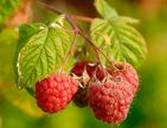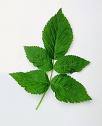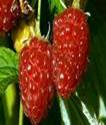| Kingdom | Plantae |
| Division | Magnoliophyta |
| Class | Magnoliopida |
| Order | Rosales |
| Family | Rosaceae |
| Genus | Rubus |
| Species | R. idaeus |
| Binomial name | Rubus idaeus |
Other Common Names:
The other common names for the shrub raspberry are Raspberry Leaf and Red Raspberry.
History
Raspberry's botanical name, Rubus, describes the plant as a bramble; an alternate translation is red. Both meanings describe this prickly shrub with the ruby-hued fruit.

Fossilized remains of raspberries have been found in Switzerland that verifies the herb's existence at the time of Christ.
It is highly likely raspberries also grew, with lingonberries, on slopes in ancient Crete.
Description
A shrub belonging to the Rosaceae family, the raspberry has stems armed with blunt prickles. The stalks, which are biennial, die in the second year after fructification. The root stock, which is perennial, emits new ones each year.


Range
Red raspberry occurs throughout most of the temperate regions of the world .In North America it grows from Alaska through Canada to Newfoundland, southward to North Carolina and Tennessee in the East, and to Arizona, California, and northern Mexico in the West. Raspberry grows across northern Europe to north-western Asia. It is cultivated in Hawaii and throughout much of North America and has naturalized in many locations.
Habitat
Raspberry is seen growing in thickets, clearings and open woods, widespread across the western boreal regions, circumpolar. Thus it is found in open woodland and streamsides.Raspberry will grow in light (sandy), medium (loamy), hard (clay) soil. It is / is important for the soil to be well drained.
Cultivation
Seed requires stratification and is best sown in early autumn in a cold frame. Stored seed requires one month stratification at about 3�c and is best sown as early as possible in the year. Prick out the seedlings when they are large enough to handle and grow on in a cold frame. Plant them out into their permanent positions in late spring of the following year. Cuttings of half-ripe wood, takes place in July/August in a frame followed by tip layering in July. Plant out in autumn. Division in early spring or just before leaf-fall in the autumn.
Dig a hole twice the size of the root ball and deep enough to plant at the same level the shrub was in the container. If soil is poor, dig hole even wider and fill with a mixture half original soil and half compost or soil amendment. Carefully remove shrub from container and gently separate roots. Position in center of hole, best side facing forward. Fill in with original soil or an amended mixture if needed as described above. For larger shrubs, build a water well. Finish by mulching and watering well. If the plant is balled-and-burlapped, remove fasteners and fold back the top of natural burlap, tucking it down into hole, after you've positioned shrub. Make sure that all burlap is buried so that it won't wick water away from rootball during hot, dry periods. If synthetic burlap, remove if possible. If not possible, cut away or make slits to allow for roots to develop into the new soil. For larger shrubs, build water well. Finish by mulching and watering well. If shrub is bare-root, look for a discoloration somewhere near the base; this mark is likely where the soil line was. If soil is too sandy or too clayey, add organic matter. This will help with both drainage and water holding capacity. Fill soil, firming just enough to support shrub. Finish by mulching and watering well.
Flowering Season
Raspberry will flower in December to February which are hermaphrodite (has both male and female organs) and they are pollinated by Bees, flies.
Pests and Diseases
Raspberry affected by diseases like fusarium wilt, rusts and powdery mildew. Anthracnose is the result of a plant infection, caused by a fungus, and may cause severe defoliation, especially in trees, but rarely results in death. Scales are insects, related to mealy bugs that can be a problem on a wide variety of plants - indoor and outdoor. Young scales crawl until they find a good feeding site. Blights are cause by fungi or bacteria that kill plant tissue. Symptoms often show up as the rapid spotting or wilting of foliage.
Parts Used

The leaves and fruits are the most commonly used parts of raspberry which are used for its medicinal and commercial applications.
Medicinal Applications

• Raspberry leaves are often used to facilitate easier labour by strengthening the longitudinal muscles of the uterus, thereby increasing the strength of the contractions, and thus speeding up childbirth.
• The fruits can be used for their astringent properties, and they are also highly nutritious.
• The tea has also been shown as effective in relieving painful menstrual cramps.
• Externally, the leaves and roots are used as a gargle to treat tonsillitis and mouth inflammations, as a poultice and wash to treat sores, conjunctivitis, minor wounds, burns and varicose ulcers.
• Fresh raspberry juice, mixed with a little honey, makes an excellent refrigerant beverage to be taken in the heat of a fever.
• Raspberry leaves, taken cold, are a reliable remedy for extreme laxity of the bowels.
• The leaves, combined with the powdered bark of Slippery Elm, make a good poultice for cleansing wounds, burns and scalds, removing proud flesh and promoting healing.
• Raspberry also enriches and encourages the flow of mother's milk.
• It is also beneficial effect on the heart.
Commercial Applications

• A purple to dull blue dye is obtained from the fruit.
• A fibre obtained from the stems is used in making paper.
• A decongestant face-mask made from the fruit is used cosmetically to soothe reddened skin.
• Raspberry-scented perfumes and bath products crowd the shelves of cosmetics shops.
• Served with sugar and cream, made into jam, put on cakes and in pies, they are delicious.

Juliette de Bairacli Levy, in The Complete Herbal Book for the dog, quotes a gypsy herbal document that advises, "let all creatures with young, human and animal, and take freely of raspberry herb." For retention of puppies, Levy advises bitches be given two tablespoons powdered raspberry leaves mixed with molasses and water.
Folklore says that the fruit which has a pleasant grateful smell and taste is cordial and strengthens the stomach, stays vomiting, is somewhat astringent and good to prevent miscarriage. In New England, farmers traditionally predicted the severity of the coming winter by natural indicators such as the thickness of skin on tomatoes, the height of beaver damns, and the thickness of winter coats on farm animals. In Alaska, Dena'ina Athabascans use the height of the summer raspberry canes as a basis for predicting snowfall; short canes foretell scanty snow cover, and tall ones assure a deep, white winter.